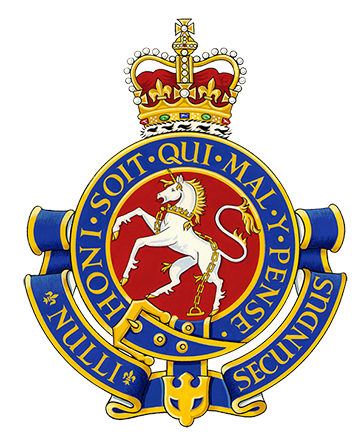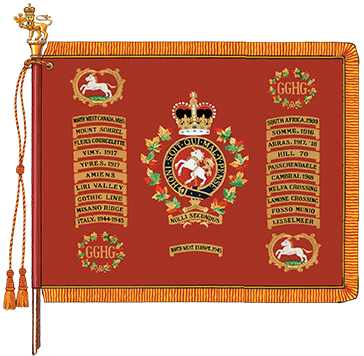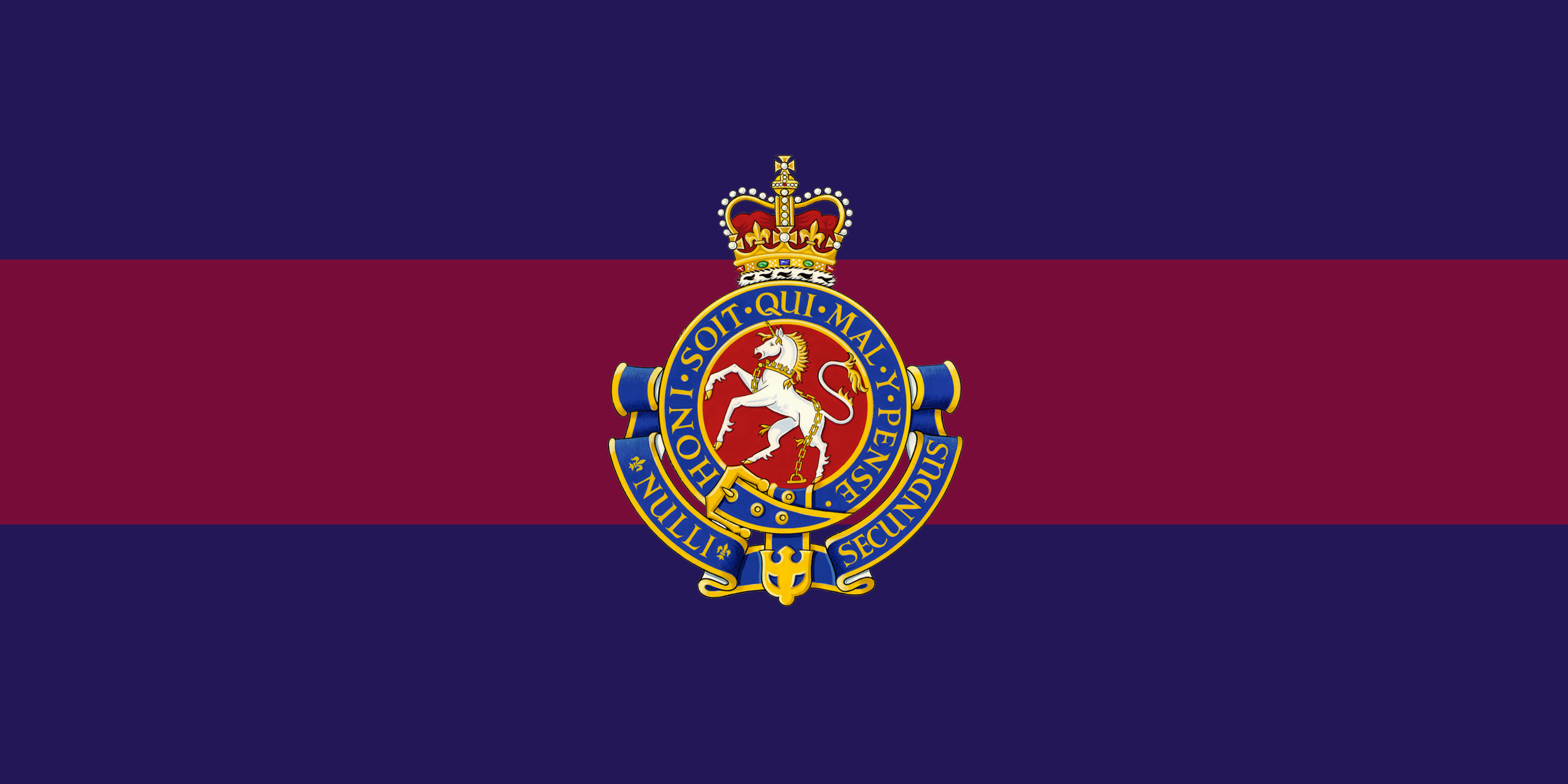The Governor General’s Horse Guards
The official lineage of The Governor General’s Horse Guards armour regiment.

Colonel-in-Chief: Vacant
Badge
Description
Gules a unicorn rampant Argent armed, crined, unguled and gorged with a coronet composed of crosses patée and fleurs-de-lis a chain affixed thereto reflexed all Or within the Garter bearing the motto HONI SOIT QUI MAL Y PENSE ensigned by the Royal Crown all proper and set upon a scroll Azure edged and inscribed NULLI SECUNDUS in letters Or.
Symbolism
The Crown represents service to the Sovereign. The Garter is taken from the badge of The Governor General's Body Guard. The unicorn, coronet and chain are from the badge of The Mississauga Horse, and, originally, they were taken from the unicorn supporter of the Royal Arms.
Motto
NULLI SECUNDUS (Second to none)
March
Men of Harlech
Alliance
British Army
The Blues and Royals (Royal Horse Guards and 1st Dragoons); and the 1st The Queen's Dragoon Guards.
Affiliation
The Royal Canadian Dragoons
Standard

Camp flag

Battle honours
North West Rebellion
NORTH WEST CANADA, 1885.
The South African War
SOUTH AFRICA, 1900.
The First World War
MOUNT SORREL; SOMME, 1916; Flers-Courcelette; Ancre Heights; ARRAS, 1917, '18; Vimy, 1917; HILL 70; YPRES, 1917; Passchendaele; AMIENS; Scarpe, 1918; HINDENBURG LINE; Canal du Nord; Cambrai, 1918; VALENCIENNES; SAMBRE; FRANCE AND FLANDERS, 1915-18.
The Second World War
LIRI VALLEY; Melfa Crossing; GOTHIC LINE; LAMONE CROSSING; Misano Ridge; Fosso Munio; ITALY, 1944-1945; Ijsselmeer; NORTH-WEST EUROPE, 1945.
South-West Asia
AFGHANISTAN
Lineage
This Reserve Force regiment originated on 17 May 1889 and incorporates the following regiments.
The Governor General's Horse Guards originated in Toronto, Ontario on 17 May 1889, when the 'Governor General's Body Guard for Ontario' was authorized to be formed.Footnote 1 It was redesignated 'The Governor General's Body Guard' on 13 July 1895.Footnote 2 On 15 December 1936, it was amalgamated with 'The Mississauga Horse' (see below) and redesignated 'The Governor General's Horse Guards'.Footnote 3 It was redesignated: '2nd (Reserve) Regiment, The Governor General's Horse Guards' on 11 February 1941;Footnote 4 '3rd (Reserve) Armoured Regiment, (The Governor General's Horse Guards)' on 1 April 1941;Footnote 5 'The Governor General's Horse Guards (3rd Armoured Regiment)' on 4 February 1949;Footnote 6 and 'The Governor General's Horse Guards' on 19 May 1958.Footnote 7
Notes:
On 1 November 1920 The Governor General's Body Guard was organized as a two regiment unit with the 1st Regiment on the Non Permanent Active Militia order of battle, and the 2nd Regiment on the Reserve order of battle (GO 185/20).
On 16 April 1935 the 1st Regiment was redesignated the 1st Regiment (4th Canadian Mounted Rifles Battalion, CEF) (GO 47/35). The reserve unit was disbanded on 14 December 1936 (GO 3/37).
The Governor General's Body Guard was disbanded for the purpose of reorganization on 3 January 1921 and reorganized the same day (GO 60/21). This change was administrative and does not affect the lineage of the regiment.
The Governor General's Body Guard was disbanded for the purpose amalgamation on 14 December 1936 and reorganized the next day (GO 199/36). This change was administrative and does not affect the lineage of the regiment.
The Mississauga Horse originated in Toronto, Ontario on 1 April 1903, when the 'Toronto Light Horse' was authorized to be formed.Footnote 8 It was redesignated: '9th Toronto Light Horse' on 22 December 1903;Footnote 9 '9th Mississauga Horse' on 1 May 1907;Footnote 10 'The Ontario Mounted Rifles' on 15 March 1920;Footnote 11 and 'The Mississauga Horse' on 1 April 1924.Footnote 12 On 15 December 1936, it was amalgamated with 'The Governor General's Body Guard', as above.
Notes:
Upon redesignation as The Ontario Mounted Rifles on 15 March 1920 (see above), it was organized as a three regiment unit with the 1st (Mississauga) Regiment (4th Canadian Mounted Rifles Battalion, CEF) on the Non Permanent Active Militia order of battle, and the 2nd Regiment (7th Canadian Mounted Rifles Battalion, CEF) and 3rd Regiment (8th Canadian Mounted Rifles Battalion, CEF) on the Reserve order of battle.
The Ontario Mounted Rifles were disbanded for the purpose of reorganization on 1 April 1921 and reorganized the same day (GO 129/21). This change was administrative and does not affect the lineage of the regiment.
Upon redesignation as The Mississauga Horse on 1 April 1924 (see above) the 1st (Mississauga) Regiment was redesignated the 1st Regiment (4th Canadian Mounted Rifles Battalion, CEF) (GO 46/24).
On the 15 November 1926, the 2nd Regiment was redesignated the 2nd Regiment (7th Regiment Canadian Mounted Rifles, CEF) and the 3rd Regiment (8th Regiment Canadian Mounted Rifles Battalion, CEF) was redesignated the 3rd Regiment (no CEF designation) (GO 74/26).
On the 15 July 1929 the 3rd Regiment was redesignated the 3rd Regiment (216th Battalion, CEF) (GO 95/29).The reserve units were disbanded on 14 December 1936 (GO 3/37).
The Mississauga Horse were disbanded for the purpose amalgamation on 14 December 1936 and reorganized the next day (GO 199/36). This change was administrative and does not affect the lineage of the regiment.
Perpetuations
'4th Battalion, Canadian Mounted Rifles, CEF'; '7th Regiment, Canadian Mounted Rifles, CEF'; and '216th "Overseas" Battalion, CEF'
Headquarters Location
Toronto, Ontario
Operational history
North West Rebellion
The Governor General's Body Guard for Ontario was mobilized for active service on 10 April 1885.Footnote 13 It served in the Alberta Column of the North West Field Force.Footnote 14 The unit was removed from active service on 24 July 1885.Footnote 15
South African War
The Governor General's Body Guard contributed volunteers for the Canadian contingents in the field.Footnote 16
The First World War
The 4th Battalion, Canadian Mounted Rifles, which was authorized on 7 November 1914 as the '4th Regiment, Canadian Mounted Rifles, CEF',Footnote 17 embarked for Britain on 18 July 1915.Footnote 18 It disembarked in France on 24 October 1915,Footnote 19 where it fought as part of the 2nd Brigade Canadian Mounted Rifles until 31 December 1915, when it was converted to infantry and allocated to the 8th Infantry Brigade, 3rd Canadian Division.Footnote 20 The regiment was redesignated the '4th Battalion, Canadian Mounted Rifles, CEF' on 1 January 1916.Footnote 21 The battalion was disbanded on 6 November 1920.Footnote 22
The 7th Regiment, Canadian Mounted Rifles was authorized on 7 November 1914 as the '7th Regiment, Canadian Mounted Rifles, CEF'.Footnote 23 The regiment, broken-up in Canada, supplied the '2nd Canadian Divisional Cavalry Squadron' (see the 1st Hussars chart) and two squadrons formed the 'Canadian Mounted Rifles Depot' in England.Footnote 24 The regiment was disbanded on 11 April 1918.Footnote 25
The 216th Battalion, which was authorized on 15 July 1916 as the '216th "Overseas" Battalion, CEF',Footnote 26 embarked for Britain on 18 April 1917.Footnote 27 Its personnel were absorbed by the 3rd Reserve Battalion, CEF' on 5 May 1917 to provide reinforcements to the Canadian Corps in the field.Footnote 28 The battalion was disbanded on 1 September 1917.Footnote 29
The Second World War
Details from the regiment were called out on service on 26 August 1939 and then placed on active service on 1 September 1939, under the designation 'The Governor General's Horse Guards, CASF (Details)', for local protection duties.Footnote 30 The details called out on active service were disbanded on 31 December 1940.Footnote 31 Subsequently, the regiment mobilized the '2nd Canadian Motorcycle Regiment, CASF (GGHG)' for active service on 24 May 1940.Footnote 32 It was converted to armour and redesignated: 'The Governor General's Horse Guards, CASF' on 9 February 1941;Footnote 33 '3rd Armoured Regiment (The Governor General's Horse Guards), CASF' on 11 February 1941;Footnote 34 '3rd Armoured Reconnaissance Regiment (The Governor General's Horse Guards), CAC, CASF' on 1 January 1943;Footnote 35 and '3rd Armoured Reconnaissance Regiment (The Governor General's Horse Guards), RCAC, CASF' on 2 August 1945.Footnote 36 It embarked for Britain on 9 October 1941.Footnote 37 The regiment landed in Italy on 19 December 1943 as part of the 5th Armoured Brigade, 5th Canadian Armoured Division.Footnote 38 On 20 February 1945 the regiment moved with the 1st Canadian Corps to North-West Europe, where it continued to fight until the end of the war.Footnote 39 The overseas regiment was disbanded on 31 January 1946.Footnote 40
South-West Asia
From 2002 to 2014, The Governor General’s Horse Guards reinforced various CAF units deployed to Afghanistan.Footnote 41
Page details
- Date modified: